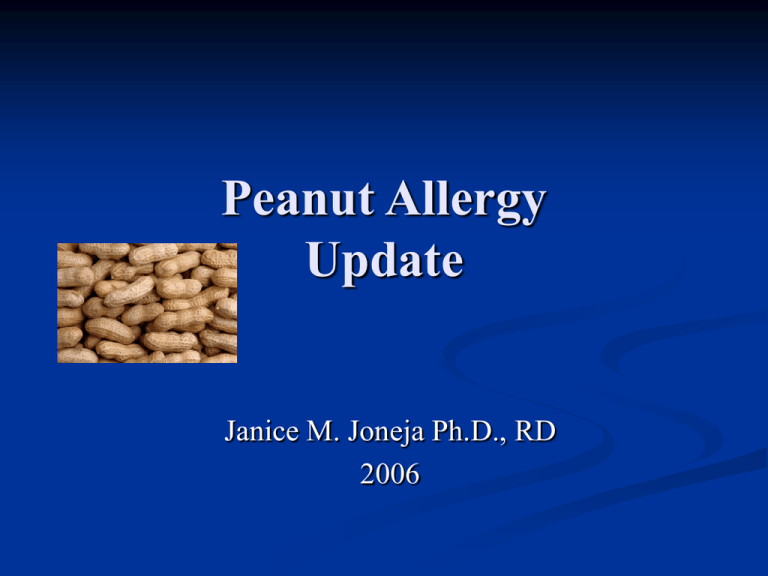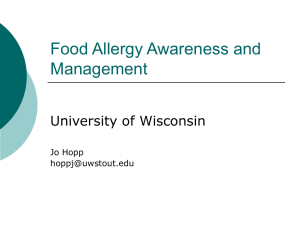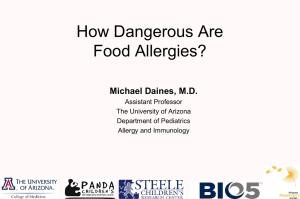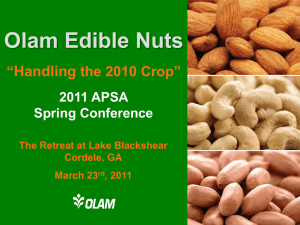Part 4: Update on Peanut Allergy, Update on Probiotics in the
advertisement

Peanut Allergy Update Janice M. Joneja Ph.D., RD 2006 Peanuts and Anaphylaxis Peanuts are one of the most frequently cited causes of life-threatening anaphylactic reactions in Western countries Peanuts, tree nuts, fish, and shellfish are the foods most frequently identified as causes of anaphylaxis, and of these, peanuts seem to prompt the greatest concern The incidence of peanut allergy was reported to have doubled in American children less than 5 years of age in the five years between 1998 and 2003 _____________ Sampson 2003 2 Incidence of Peanut Allergy One study reported that allergy to peanuts: Accounts for 28% of food allergies in children (72% of food allergies were to foods other than peanut) In peanut-allergic individuals, reactivity to peanut develops: Before one year of age in 46% Before 15 years of age in 93% The true incidence of peanut allergy in any population is largely a matter of speculation, based on questionnaires and occasional epidemiological studies _____________________ Moneret-Vautrin et al 1998 3 Fatalities Due to Food Allergy 2001 report of 32 fatal cases of anaphylactic reactions to foods in USA Peanut was responsible for 14 (67%) and possible cause in a further 6 (55%) Tree nuts the cause in 7 (33%) and possible cause in a further 3 (27%) Two cases thought to be due to milk and fish (1 [19%] each) Most of the victims were adolescents or young adults All but one were known to have food allergy before the fatal event All but one were known to have asthma Peanuts and tree nuts accounted for more than 90% of the fatalities _____________ Bock et al 2001 4 Peanut Allergy in Populations Allergy to peanut is far less prevalent in China, despite the high rate of peanut consumption Allergy to all foods reported to affect only 3.4% – 5.0% of the residents of a select population in China Fish, shrimp, crab, and seaweed were the major allergens In 29 children aged 2 to 12 years with diagnosed food allergy in the Chinese population studied, none had signs of clinical allergy to peanut Peanut allergy in China is virtually non-existent, whereas in the USA about 3 million people report being allergic to peanuts The Chinese-American population living in the USA had an incidence of peanut allergy similar to that of the general US population _____________ Beyer et al 2001 5 Peanut Allergy in the UK 8 children under 16 years of age died from food allergy in ten years 1990 -2000 (= 1 death per 16 million children each year) Milk caused 4 deaths No child younger than 13 years died from eating peanuts One child died from an overdose of adrenaline used to treat a mild food reaction _____________ Pumphrey 2000 6 Incidence of Peanut Allergy in Canadian Children The prevalence of peanut allergy in children kindergarten through Grade 3 in randomly selected schools in Montreal: Between 1.5% and 1.76% of 4339 responding families Study based on: Questionnaire Skin-prick tests Measurement of peanut-specific IgE in blood Oral peanut challenge ______________ Kagan et al 2003 7 Processing of Peanuts and Allergenicity Roasting of peanuts has been demonstrated to increase their allergenicity, compared to the same variety of peanut when processed by other methods Roasting gives improved flavour and taste, and is the method used for processing peanuts and peanut butter in North America Roasted peanut is more likely to trigger a severe anaphylactic reaction than the fried or boiled peanut, which is the form in which people in countries such as China consume the food ______________ Maleki et al 2000 8 Effect of Temperature on Allergenicity Much higher temperature reached in roasting in comparison to frying or boiling Peanut proteins are not degraded at high temperatures, and retain their potential to trigger an allergic reaction even after cooking (Class 1 allergens) Excessively high temperature changes the protein to a more insoluble form Increase in insolubility means that less of the protein will move into solution in the digestive tract, and will be more protected from digestive enzymes and destruction by gastric acid than a more soluble form would be Results in undegraded peanut protein being available as a continuous source of major allergens in the digestive tract long after the same protein in a more soluble form would have been removed from the system ______________ Kopper et al 2005 9 Allergenicity due to Immune Interaction Method of heating the proteins significantly affects the interaction between the allergen and the antibodies produced by the allergic individual Increases the likelihood of the individual developing symptoms, and probably the severity of the symptoms in an allergic reaction _________________ Mondoulet et al 2005 10 Factors in Allergenicity of Peanut Other factors that might affect the allergenicity of peanut proteins include: Type and variety of the peanut (of which there are about 14,000) Conditions under which the peanut has been grown Degree of maturation of the peanuts ______________ Chung et al 2003 11 Peanut and Fat Content High fat content reduces reactivity to peanut Study of six people with a known peanut allergy; reactivity of four of the subjects significantly increased when the peanut was included in a lower-fat meal compared to when the food had a high fat content Subjects reacted to a dose equivalent to 23 times less peanut with the low-fat recipe compared to the higher fat meal _________________ Grimshaw et al 2003 12 Legume Allergy There is no evidence to support the thinking that peanut-allergic individuals should avoid all legumes In laboratory experiments, cross-reactivity between peanut and soy is quite frequent, but in clinical trials, the cross-reactivity is quite uncommon One study reports only 2 out of 41 peanut-allergic patients reacted mildly to other members of the legume family Avoidance of legumes such as soy, chick peas, lentils, beans, peas, licorice, carob, and all other members of the Leguminoceae family, to which peanut belongs, is only necessary when allergy to the individual foods has been identified. _________________________ Bernhisel-Broadbent et al 1989 13 Tree Nut Allergy Tree nuts are botanically unrelated to peanuts It is not necessary to avoid tree nuts such as hazelnuts (filberts), Brazil nuts, walnuts, almonds, macadamia nuts, pine nuts, pistachios, etc. unless the individual has an allergy to them Nuts in a nut mixture are very difficult to distinguish from each other Risk of tree nuts, especially nut mixtures, to contain, or to be contaminated by peanuts A person who has demonstrated allergy to peanuts is usually advised to avoid nuts of all types in the interests of safety 14 Peanut and Soy Allergy Increase in the incidence of soy allergy, especially in children May be the result of exposure to the allergenic protein, in the form of soy-based infant formulas, in early infancy when the child is at highest risk for allergic sensitization Soy and peanuts contain a similar allergen, exposure to the soy allergen in infant formula could prime the child’s immune system to respond to the peanut allergen, even when he or she shows no signs of allergy to soy As a result, the child could exhibit allergic symptoms on an apparent first exposure to the peanut. ____________ Lack et al 2003 15 Progression of Peanut Allergy Peanut allergy, like many early food allergies, can be outgrown In 2001 pediatric allergists in the U.S. reported that about 21.5 per cent of children will eventually outgrow their peanut allergy1 Those with a mild peanut allergy, as determined by the level of peanut-specific IgE in their blood, have a 50% chance of outgrowing the allergy2 Only about 9% of patients are reported to outgrow their allergy to tree nuts3 __________________ 1Skolnick et al 2001 2Fleischer et al 2003 3Fleischer et al 2005 16 Maintaining Tolerance of Peanut When there is no longer any evidence of symptoms developing after a child has consumed peanuts, it is preferable for that child to eat peanuts regularly, rather than avoid them, in order to maintain tolerance to the peanut Children who outgrow peanut allergy are at risk for recurrence, but the risk has been shown to be significantly higher for those who continue to avoid peanuts after resolution of their symptoms _________________ Fleischer et al 2004 17 The Peanut Safe Environment Important measures for a peanut-safe environment should include: Ensuring that all personnel in a peanut-safe facility are well-informed about the dangers to the peanutallergic person of accidental contamination Clear strategies for maintaining the facility in a peanut-safe condition, with strict rules about cleaning Informing everyone entering the facility to avoid introducing peanuts into the area, and the reasons for the restrictions 18 The Peanut Safe Environment continued Education of the peanut-allergic person concerning avoidance of their own exposure to peanuts, including: Avoidance of foods likely to contain, or be contaminated by, peanuts Being aware of all terms on food labels that would indicate the possible presence of peanut Carrying an Epipen of injectable adrenalin, and being familiar with its use in case of accidental exposure and an allergic reaction Wearing a MedicAlert tag or bracelet in case of loss of consciousness in an allergic reaction 19 The Peanut Safe Environment continued Informing all staff in the facility about emergency procedures should anyone in the area develop symptoms and require medical treatment. Such information should include: Familiarity with the use of the Epipen where appropriate Contacting key care-givers such as parents and guardians of children, and the person’s doctor or other health provider Instructions for transporting the individual to the nearest hospital in the quickest way possible 20 Peanut Oil Highly refined peanut oil contains barely detectable amounts of peanut protein, and should be safe for consumption by most peanut-allergic individuals There is no guarantee that any peanut oil is completely free from peanut protein Threshold doses of peanut as low as 100 mcg reported to elicit (mild) symptoms in test subjects: may be below level of detection A person anaphylactic to peanut is strongly advised to avoid all types of peanut oil entirely Cold-pressed oils (also labelled “pure-pressed”, “expeller pressed” or “unrefined”) in particular should be avoided. _________________ Hourihane et al 1997 21 Probiotics, Prebiotics, Synbiotics Bacteria as Therapeutic Agents Microorganisms in the Bowel The healthy large bowel sustains a resident microflora of bacteria, fungi, and other harmless microorganisms Beneficial effects include: Synthesis of vitamins: Vitamin K Biotin Thiamin Folic acid Vitamin B12 Interaction with immune cells to maintain a healthy epithelium Positive competition with invading pathogens to resist disease 23 Resident Microflora Gut microflora of a breastfed infant is quite different from that of a formula-fed baby An individual’s bowel microflora is established at weaning Remains stable throughout life unless events intervene Individuals in the same household, eating the same diet, may have a vastly different bowel microflora After oral antibiotics several microbial species will be killed, but after about 6 months the previous strains become re-established and microflora returns to its pre-antibiotic state 24 Bowel Microflora and Allergy The type of gut colonization during the first weeks of life may predispose an individual to atopic disease The gut microflora influences: Resistance to infection Immunological environment for subsequent challenges, including food allergens May influence predominance of Th1 or Th2 response Probiotics may alter the gut microenvironment by changing the types of microorganisms present and the cytokines produced by the local immune cells _________________ Kirjavainen et al 1999 25 Probiotic Living micro-organisms within a food that is designed to provide health benefits beyond the food’s inherent nutritional value The types of micro-organisms used have certain characteristics to be of any value: Have a beneficial effect within the bowel Must be capable of living within the human bowel without causing any harm to the host. ______________ Thompson 2001 26 Probiotic Characteristics Probiotic micro-organisms alter the gut microflora by competitively interacting with the existing flora by: Production of antimicrobial metabolites Modulating the local immune response to the indigenous micro-organisms Saccharolytic species: Use carbohydrates as substrate Produce beneficial metabolites _____________ Shanahan 2000 27 Possible Use for Probiotics Trials in disease situations such as : Diarrheal diseases Re-establishment of normal intestinal microflora after antibiotic therapy Inflammatory bowel diseases Fungal disease (e.g. candidiasis) Cancers Cholesterol lowering Prevention of allergic diseases e.g. eczema Management of lactose intolerance 28 Why Probiotics? The desire by consumers to use natural methods for health maintenance rather than long-term chemotherapeutic agents (i.e. antibiotics) Expectation that food will become a source of prolonged well-being Speculation that the probiotic market will expand rapidly Depends on the reliability of claims for the effectiveness of these products in disease prevention and control 29 Micro-organisms Used as Probiotics Examples of bacteria: Lactobacilli Bifidobacteria Strains of enterococci Requirements for survival of probiotic strains: Must be able to survive passage through the hostile environment of the stomach and upper small intestine Resist the effects of intestinal secretions Attach to intestinal cells on reaching the large bowel, Thrive within its physiological and nutritional milieu. 30 Forms of Probiotic Agents Examples of food supplements containing live culture: Yogurts Fermented milks Fortified fruit juice Powders Capsules Tablets Sprays 31 Prebiotics Non-digestible food ingredients that selectively stimulate a limited number of bacteria, to improve health Examples: Fructo-oligosaccharides (FOS) Lactulose Galacto-oligosaccharides (GOS) Provided in: Beverages and fermented milks Health drinks and spreads Cereals, confectionery, cakes Food supplements 32 Synbiotics Combine prebiotics and probiotics Prebiotic substrate should enhance survival of probiotic bacteria Example: Bifidobacteria + fructo-oligosaccharide (FOS) In order to establish the new species, need to continue to provide live culture, and appropriate substrate 33 Probiotics and Lactose Intolerance Lactobacilli, bifidobacteria and Streptococcus thermophilus, assist in reducing the symptoms of lactose intolerance Produce the enzyme beta-galactosidase (lactase) in yogurt Microbial lactase breaks down lactose The fermented milk itself delays gastrointestinal transit, thus allowing a longer period of time in which both the human and microbial lactase enzyme can act on the milk lactose. 34 Microflora and Lactose Intolerance Lactose tolerance in people who are deficient in lactase may be improved by continued ingestion of small quantities of milk Does not improve or affect the production of lactase in the brush border cells of the small intestine Continued presence of lactose in the colon contributes to the establishment and multiplication of bacteria capable of synthesizing the beta-galactosidase enzyme over time Resident micro-organisms will break down the undigested lactose in the colon Reduces the osmotic imbalance within the colon that is the cause of much of the distress of lactose intolerance _________________ de Vrese et al 2001 35 Clinical Trials of Probiotics Not all probiotics have been tested in clinical studies with regard to allergy prevention or treatment L. bulgaricus seemed to have no effect on immune parameters, whereas it was associated with lower frequency of allergies L. acidophilus consumption accelerated recovery from food allergy symptoms These effects have also been observed in infants with eczema and cow's milk allergy using infant formulas supplemented with L. rhamnosus. 36 Trials on Probiotics and Eczema Prevention Pregnant women took capsules containing Lactobacillus rhamnosus GG (LGG) during the last two to four weeks of pregnancy The newborn infants were given the same microorganism from birth to six months Breast-feeding mothers continued to take the capsules during lactation The babies were given the bacteria mixed with water by spoon Subjects taking the probiotic had a reduced risk of developing atopic dermatitis (eczema) compared to controls up to 4 years of age Other studies found no reduced incidence of eczema in babies treated with probiotics _________________ Kalliomaki et al 2003 37 Prebiotics and Eczema A few preliminary studies suggested increased bifidobacteria may be associated with a decreased incidence of atopic dermatitis Stool of infants fed formula containing oligosaccharides (FOS and GOS) in comparison to infants not fed the test formula had: Increased numbers of bifidobacteria and lactobacilli Increased amount of short chain fatty acids Increased proportion of acetate Decreased proportion of propionate Lower stool mean pH This is closer to that seen in breast-fed infants compared to infants fed control formula _______________ Ben XM et al 2004 ____________ 38 Knol et al 2005 Effects of Probiotics on Intestinal Functions and Immune Responses Probiotics have effects on a number of intestinal functions and immune responses that may be beneficial in food allergy management, such as: Repair of intestinal barrier function Repair of tight junctions Enhanced mucin production Effects on dendritic cell function Skewing of T cells towards Th1 rather than Th2 Exclusion of pathogens by competition for substrate Suppression of intestinal inflammation _______________ Saxelin et al 2005 39 Status of Probiotics as Therapy Great care must be taken in transferring data from laboratory and experimental animal studies into human use Applies also to the use of known probiotics, some of which are already present in human nutrition, such as yoghurt Not all strains of bacteria in use as probiotics are completely harmless Their immune-modifying effects and possible antiallergic and anti-cancer actions require large clinical studies 40








